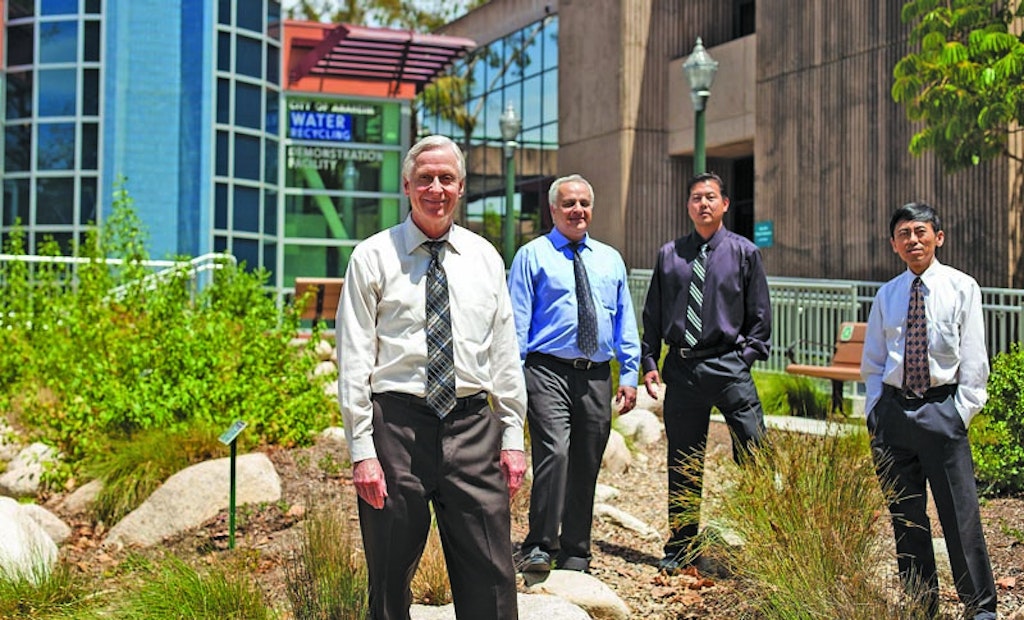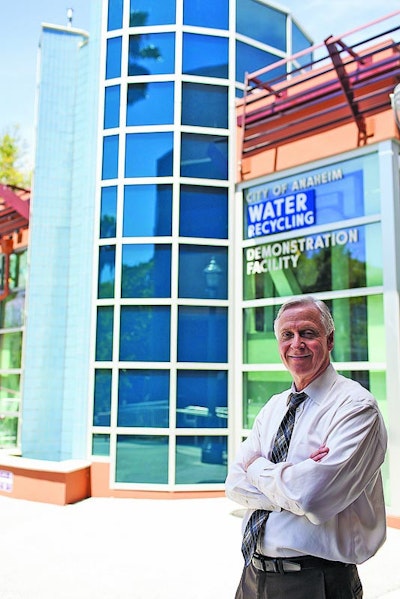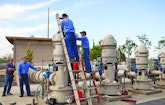
Interested in Infrastructure?
Get Infrastructure articles, news and videos right in your inbox! Sign up now.
Infrastructure + Get AlertsCalifornia reported one of the driest years on record in 2013, prompting Gov. Jerry Brown to declare a drought State of Emergency in January 2014 and to ask Californians to reduce their water consumption by 20 percent. Careful planning and targeted capital investment have armed the City of Anaheim with the tools it requires to weather the drought.
Anaheim is a city of about 350,000 people located in Orange County, part of the Los Angeles metropolitan area. A robust water supply supports not only its citizens and industries but also a thriving tourist trade with such attractions as the Disneyland Resort, Angel Stadium of Anaheim, Honda Center and Anaheim Convention Center, the West Coast’s largest convention center.
It’s no surprise that water first attracted people to the area. “It was settled in 1857 by winemakers of German descent who irrigated their vineyards with the resources of the Santa Ana River,” says Don Calkins, assistant general manager of Water Services with the City of Anaheim Public Utilities. “The settlement’s municipal water system opened on Sept. 15, 1879, with one shallow well, a 20,000-gallon storage tank built of redwood and a 4-inch wooden pipe to distribute water down four blocks of the main street.”
Diverse water supply
Today, the city is served by 750 miles of water distribution pipe and relies on a diverse water supply sourced from groundwater from its own deep wells, and water imported from Northern California and the Colorado River by the Metropolitan Water District of Southern California. The Anaheim Water Utility serves the city and a few additional unincorporated areas in Orange County.
The utility is responsible for the quality of the city’s water supply, transporting water to and throughout the city and operating the system. It oversees system planning, design and maintenance but outsources most construction, other than emergency repairs and installation of short lengths of pipe.
Rapid growth in the 1950s resulted in construction of new water infrastructure with 95 percent of the city’s water pipes installed after 1950. Pipe diameters range from 4 to 36 inches. Slightly more than half the smaller water pipes are cast iron, and one-third are ductile iron. In descending order, asbestos cement, PVC and steel make up the rest. Concrete cylinder pipe is used for some larger transmission mains.
“A lot of Anaheim is located on the alluvial plain of the Santa Ana River and we’re fortunate that it’s noncorrosive soil,” Calkins says. “However, there are some pockets of corrosive soil in the parts of town located on hilly terrain. That’s where we’ve installed the PVC pipes.”
The city installs an average of three to five miles of pipe each year as part of its program to replace aging infrastructure and to improve fire flows in certain areas.
“Back in the 1990s, we conducted an extensive multiyear program of rehab and replacement of cast iron pipes in the older part of town,” Calkins says. “If the pipe was undersized, we’d replace. We’re familiar with the various trenchless repair technologies, but it has rarely been deployed in Anaheim. In this program, if the pipe was adequately sized, we’d rehab it by pigging out the interior and installing a cement mortar liner. That work was completed in 2003.”
In-house crews conduct inspection and acoustic leak detection programs, with additional leak detection performed by outside contractors.
Water system in good condition
“Overall, Anaheim’s water system is in very good condition,” Calkins says. “Compared against other water utilities in the country, the number of main breaks as well as the number of unplanned outages per customer account in Anaheim have both been rated consistently below the American Water Works Association top quartile benchmark.”
The city has been a hive of water-related construction activity in recent years, focusing on increasing available water supplies, enlarging rebuilding storage capacity, and improving pumping efficiency and capacity.
Recently completed projects include: an expansion of its Hidden Canyon Pump Station; rehabilitation of its 920-million-gallon Walnut Canyon Reservoir; construction of the Nohl Canyon Water Storage Tank, a 10-million-gallon, above-ground drinking water storage facility; and completion of the Linda Vista Complex, a new 4-million-gallon water storage facility.
On tap for the near future:
- Refurbishing the La Palma Complex. Built in the mid-1950s, the existing facility includes two water storage reservoirs and a pump station. Planning includes 4 million gallons of water storage and pumps with a capacity of more than 14 mgd. Construction is anticipated to begin in 2015.
- Construction of the 1.6-million-gallon Windy Ridge Water Storage Tank in east Anaheim, expected to be completed by summer 2017.
The city is currently completing construction of Well 58, a new high-capacity potable water well designed to replace two shallow wells.
“We typically divide these projects into two contracts,” Calkins says. “We’ve already drilled the 1,200-foot well to the deeper aquifers and now we’re headed for the second phase, which involves installing a well house, pump, and associated mechanical and electrical equipment.”
The city also recently constructed the Anaheim Infiltration Well Pilot Project, a large-diameter infiltration well designed to capture, treat and infiltrate city stormwater runoff. Stormwater passes through a settling tank designed to eliminate heavy particles and then passes through a hydrocarbon filter before infiltrating into the aquifer.
“It’s a small-scale project,” says Calkins. “Infiltrating the water will help reduce flows to the storm drain system and simultaneously recharge the groundwater basin, but we’re monitoring the site to see if it has any impacts on groundwater quality.”
Prepared for drought
Anaheim is taking the current drought seriously. It’s in good shape to handle this emergency thanks to securing additional water supplies, increasing storage capacity, reducing system water loss and encouraging conservation. The city has calculated that it already has enough water to take it through much of 2015.
“We want to encourage as much voluntary conservation as possible,” Calkins says. “Half of the water used in Anaheim is used for landscaping, so that’s an obvious place to concentrate on conservation.”
However, reduced demand places the utility in a conundrum. With revenue based on water consumption, conservation is taking a bite out of the utility’s revenue stream.
“About 80 to 90 percent of revenue is based on commodity sales and 10 to 20 percent is fixed revenue relating to the expense of selling water,” says Calkins. “Over the last five years, we’re adjusting to a combination of reduced revenue and reduced demand that is the result of both conservation outreach efforts and the recession.”
Balancing rates with consumption
The utility recently hired a consultant to help optimize the balance between rates, consumption and costs against future demand forecasts.
“If there’s one thing that irritates customers it’s asking them to conserve water and then raising their rates,” says Calkins. “As the economy comes back we can expect to see increased revenue going forward. In the meantime, we’ve tweaked up rates a little each year to avoid hitting the customers hard.”
Calkins says that he believes a city-owned water utility will find itself more capable of accommodating the concerns of water customers over the long haul.
“With a city-owned utility, there’s no stockholder and no dividend to be concerned about,” he says. “Our owners are our customers and that allows us to make sure we concentrate our focus on them.”











